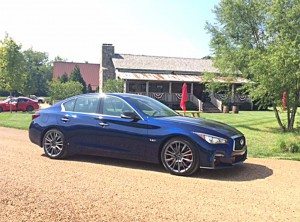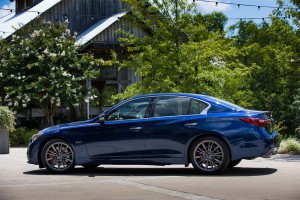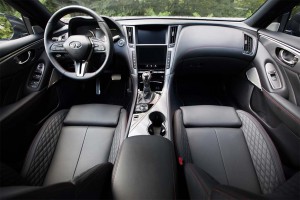There always seems to be that one product that truly represents a brand: in the luxury category the list is likely to include the BMW 3-Series, the Mercedes-Benz S-Class and the Audi A6. Despite its rapidly expanding line-up and the growing shift from passenger cars to SUVs, the Q50 is the model most folks are likely to think about when talk turns to Infiniti.
In various incarnations, it dates back to the earliest days of the brand and has been the brand’s best-seller since the days when it was known by such designations as the G30 and G35. Now dubbed the Q50, the sedan has remained Infiniti’s top model since undergoing a complete makeover in 2016. And now, just two years later, it’s getting a welcome, if not extensive, mid-cycle update.
The 2018 refresh of the Infiniti Q50 isn’t going to deliver any major surprises. There are some modest exterior and interior visual updates, some additional technology and subtle changes to the unique drive-by-wire Direct Adaptive Steering System. There’s also a new hierarchy of trim levels, starting with the now base-level Q50 Pure, and running up to the top-line Q50 Red Sport 400.
With some products, that might seem skimpy, but as we found during a drive through the Tennessee countryside not far from the Infiniti’s U.S. headquarters in Nashville, that’s enough to keep the Q50 solid in its competitive set.
Let’s start with the styling updates. The goal was to give the 2018 version a bit sportier, wider look, with a slightly revised version of the signature Infiniti grille, new LED headlamps and, in the rear, a new trim panel above the Q50’s dual tailpipes, as well as LED taillamps. The Q50 Sport also gets a new diffuser. Front and rear fascia have been slightly tweaked, too, the front featuring new foglamp shapes.
The interior updates are also modest but apparent, starting with a revised and more ergonomic three-spoke steering wheel, new contrast IP stitching, an updated shift level and revised gauge lighting. There’s also optional ambient lighting. On Sport models, the paddle shifters have now been moved from the column to the steering wheel itself.
A day’s driving revealed that there’s more just out of sight – and out of ear, if you will, with Infiniti engineers improving the Q50’s noise, vibration and harshness.
As before, there are four engine packages available, all but the hybrid relying on turbocharging. The line-up starts with the 200-horsepower 2.0-liter inline-four, followed by two versions of Infiniti’s award-winning 3.0-liter twin-turbo V-6. In Sport trim it makes 300 horsepower, the Red Sport 400 bumping that up, appropriately enough, to 400 hp.
(Infiniti pushing the upper limits for a luxury SUV with QX80 Monograph. Click Here to check it out.)
You get all of those engines paired with a seven-speed automatic – slightly dated in the age of eight-, nine- and 10-speed gearboxes. All three can be ordered in either rear-drive or all-wheel-drive configurations.
Fuel economy numbers range from 23 mpg City, 30 Highway and 25 Combined with the rear-drive 2.0t engine (22/28/24 in all-wheel-drive) to 20/26/22 for the Red Sport rear-drive (19/26/22 with AWD).
The fourth powertrain package is a 360 hp (combined) hybrid that pairs a 3.5-liter V-6 with a 50 kilowatt electric motor. The gas-electric package bumps mileage up to 27/32/29 in rear drive and 26/32/28 in AWD.
As noted, many of the updates for 2018 are modest. But they don’t go unnoticed, as we found out during a day driving the Q50 Sport package with the Direct Adaptive Steering. That became the world’s first mass market drive-by-wire technology when first unveiled a couple years ago. In other words, there’s normally no direct link between the steering wheel and the steered wheels – though the system does have a default mechanical backup that automatically locks down if the electronic system were to fail.
In its first incarnation, the Adaptive package had a somewhat artificial feel to it, a lack of linearity and usable feedback. Infiniti has been tweaking the system since and the 2018 model brings it to the point where even seasoned drivers might not realize they’re driving by wire. It is definitely more linear, more precise and there’s a natural increase in effort needed as you turn into sharper corners.
The 2018 Q50 Sport model also features improved brakes, with larger four-piston calipers up front and twin-piston calipers in the back.
A driver also has the option of numerous mode settings that adjust a variety of different vehicle settings, including steering, throttle and transmission and suspension. These include Snow, Eco, Standard, Sport and Sport+, as well as personal, where you can mix and match your own settings.
The ride on the 2018 Infiniti Q50 Sport model was firm, but not harsh, in the two Sport modes. Another tweak for the new model-year has been to slightly dial back the Vehicle Dynamic Controls – nanny settings, if you prefer – so they are less intrusive. But they don’t vanish entirely, which we came to appreciate when blasting around a sharp corner where mud and gravel had washed across the pavement during a recent storm. There was only the slightest slide before the VDC system caught and corrected our turn.

Basketball superstar Stephen Curry - shown with the Q50 - recently signed on as Infiniti's brand ambassador.
(Infiniti taking F1 tech to the street with Project Black S. Click Here to check it out.)
We’ve always liked this sedan, dating back to the days when it was the G30. The Q50 bumped things up a notch and now, with the 2018 refresh, Infiniti has embraced the concept Japanese call “kaizen,” or continuous improvement. While many luxury buyers are migrating to SUVs these days, the 2018 Q50 would give them good reason to stay with a sedan.
The first Q50 sedans are now headed for U.S. dealers, pricing for the rear-drive pure starting at $34,200, with Red Line 400 pushing you to $51,000 before options. The hybrid package starts at $50,600, meanwhile. Add $2,000 more for all-wheel-drive.
(Click Here to check out the new sedan, SUV models Infiniti unveiled in Chicago.)




